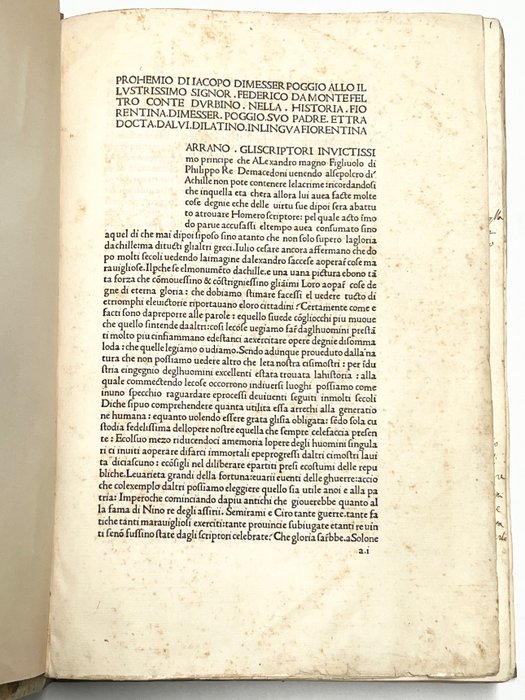
Elsa Morante - Menzogna e sortilegio - 1948
No. 76075565

No. 76075565

First editions in vernacular
Poggius Florentinus (Bracciolini) and Leonardus Brunus Aretinus works in a volume containing their histories of Florence, printed in 1476 and comprising:
POGGIUS BRACCIOLINI, Florentinus (1380-1459). Historia Florentina (in Italian, translated by Jacopo Poggio Bracciolini). Venice, Jacobus Rubeus, 8 March 1476. 95 leaves (of 116: lacking quires l-m10 and n8 as colophon). Collation: a10, b-c8, d–h10, i-k6, l-m10, n8. 41 lines, roman type.
(bound with:)
BRUNUS ARETINUS, Leonardus (1370-1444). Historiae Florentini populi (in Italian, translated by Donatus Acciaiolus). Venice, Jacobus Rubeus, 12 February 1476. 168 leaves (of 218: lacking a1-3, e1, kk1-6, quires l-o10 as books 6 and 7). Collation: a–k10, kk6, l–p10, q12, r–x10. 41 lines, roman type.
2 works in one volume, Folio (325x217mm), old vellum over boards (probably a reused of a tacketed binding). Contemporary annotations in the margins of the whole volume, and older hand has indexed the book on the head-line. Occasional light foxing, trace of use and dust between the last page of volume one and the opening page of the second work, the lower corner of quire “a” of Brunus’ work bumped and restored not affecting the text, overall a fine copy clean and crisp throughout.
FIRST EDITIONS. These two works were issued in close succession by Rubeus and therefore often found bound together. The commissioning of the translations is recorded in the account books of the Florentine merchant Girolamo Strozzi, while he was resident in Venice; he paid for scribal copies of the two translations in 1475, from the scribes Niccolò Fonzio and Ser Antonio di Jacopo. At the same time he also commissioned the more substantial Italian translation of Pliny's Historia naturalis which Jenson printed in 1478.
Poggio's near-contemporary history of Florence, somewhat shorter and written with an emphasis on military matters, was translated into Italian by his son Jacopo. The manuscript made for Girolamo Strozzi was used by the printers to set the text; this manuscript is now in Yale and was used by Hellinga to describe the printing process (see below). Although printed in Venice, the text was to be sold in Florence and to Florentines living elsewhere; the Strozzi account books indicate that copies went to the Medici bank in Bruges and to Marco Strozzi in London, as well as to Florence, Rome, Siena, and family members elsewhere (F. Edler de Roover, "Per la storia dell'arte della stampa in Italia. Come furono stampati a Venezia tre dei primi libri in volgare", La Bibliofilia 55 (1953), 107-115).
Bruni's official history of Florence was written in 1416 and paid for through a tax exemption for Bruni and his heirs; it served to provide the state of Florence with a solid historical foundation and basis for its independence. It was translated by the humanist scholar Donato Acciaiuoli (1429-1478), a member of the Medicean ruling elite in the 1460s and 1470s who was granted a state funeral in 1478. His translation into Italian of this Florentine history was commissioned by the Florentine state, as stated by Acciaiuoli in the preface; Bruni's text appeared in print in Italian several times before the original Latin, which was finally printed in the seventeenth century.
*** THE VOLUME HAS THE EXPORT LICENSE ISSUED BY ITALIAN AUTHORITIES ***
References: (1) Goff P873, HC (+Add) 13172*, IGI 7940, BMC V 215, GW M34604, ISTC IP00873000; (2) Goff B1247, HC 1562*, IGI 2202, BMC V 215, GW 5612, ISTC IB01247000.
How to buy on Catawiki
1. Discover something special
2. Place the top bid
3. Make a secure payment